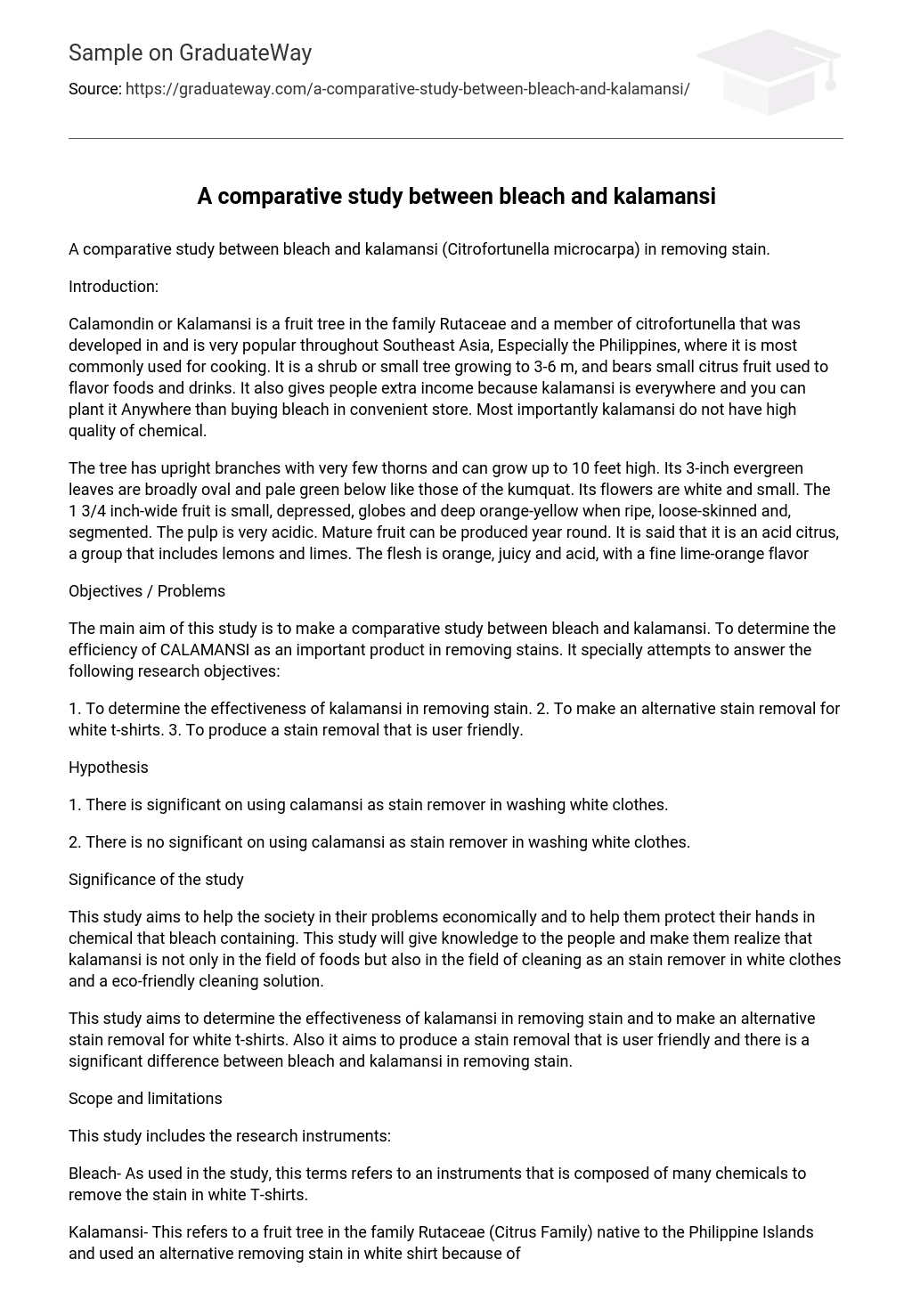Introduction
Calamondin or Kalamansi is a fruit tree in the family Rutaceae and a member of citrofortunella that was developed in and is very popular throughout Southeast Asia, Especially the Philippines, where it is most commonly used for cooking. It is a shrub or small tree growing to 3-6 m, and bears small citrus fruit used to flavor foods and drinks. It also gives people extra income because kalamansi is everywhere and you can plant it Anywhere than buying bleach in convenient store. Most importantly kalamansi do not have high quality of chemical.
The tree has upright branches with very few thorns and can grow up to 10 feet high. Its 3-inch evergreen leaves are broadly oval and pale green below like those of the kumquat. Its flowers are white and small. The 1 3/4 inch-wide fruit is small, depressed, globes and deep orange-yellow when ripe, loose-skinned and, segmented. The pulp is very acidic. Mature fruit can be produced year round. It is said that it is an acid citrus, a group that includes lemons and limes. The flesh is orange, juicy and acid, with a fine lime-orange flavor
Objectives / Problems
The main aim of this study is to make a comparative study between bleach and kalamansi. To determine the efficiency of CALAMANSI as an important product in removing stains. It specially attempts to answer the following research objectives:
- To determine the effectiveness of kalamansi in removing stain.
- To make an alternative stain removal for white t-shirts.
- To produce a stain removal that is user friendly.
Hypothesis
- There is significant on using calamansi as stain remover in washing white clothes.
- There is no significant on using calamansi as stain remover in washing white clothes.
Significance of the study
This study aims to help the society in their problems economically and to help them protect their hands in chemical that bleach containing. This study will give knowledge to the people and make them realize that kalamansi is not only in the field of foods but also in the field of cleaning as an stain remover in white clothes and a eco-friendly cleaning solution.
This study aims to determine the effectiveness of kalamansi in removing stain and to make an alternative stain removal for white t-shirts. Also it aims to produce a stain removal that is user friendly and there is a significant difference between bleach and kalamansi in removing stain.
Scope and limitations
This study includes the research instruments:
- Bleach- As used in the study, this terms refers to an instruments that is composed of many chemicals to remove the stain in white T-shirts.
- Kalamansi- This refers to a fruit tree in the family Rutaceae (Citrus Family) native to the Philippine Islands and used an alternative removing stain in white shirt because of its citric acid that kalamansi produce.
If this study will be successful then there will be a useful effect in the economy of the Philippines and we can utilize the resources around us. Also this study cannot affect the atmosphere.
Review of Related Literature
A smooth and slightly spiny plant, growing to a height of 3 to 5 meters. Leaflets are elliptic to oblong-elliptic, 4 to 8 cm long. Petioles are narrowly and scarcely winged, about a cm long. Flowers are axillaries, solitary, rarely in pairs, white, and short-stalked. Fruit is yellow when ripe, nearly spherical, 2 to 3.5 cm diameter, 6- to 7-celled, and thin-skinned. The skin or peel is green to yellowish green or yellow, loosely adhering to the flesh. The flesh contains a few light orange seeds. Bleaching agent: Cut fruit and apply directly on freckles.
Calamondin, a native citrus plant in the Philippines and China, is cultivated in Southeast Asia and elsewhere as an important crop. In the U.S. and Europe, it is grown mainly as an outstanding ornamental. The tree, which is often trained as a bonsai, will bloom year-round; filling the air with the aroma of citrus blossom. Flower and fruit often will appear at the same time. The tree has upright branches with very few thorns and can grow up to 10 feet high. Its 3-inch evergreen leaves are broadly oval and pale green below like those of the kumquat. Its flowers are white and small.
The 1 3/4 inch-wide fruit is small, depressed, globes and deep orange-yellow when ripe, loose-skinned and, segmented. The pulp is very acidic. Mature fruit can be produced year round. It is said that it is an acid citrus, a group that includes lemons and limes. The flesh is orange, juicy and acid, with a fine lime-orange flavor. Because of this, it is usually grouped with the limes. The small seeds are few, with characteristic green cotyledons. One bite of this fruit can pucker your mouth. The fruit, when ripe, is very sour when first tasted. Subsequent tasted fruits make your mouth sweet.





